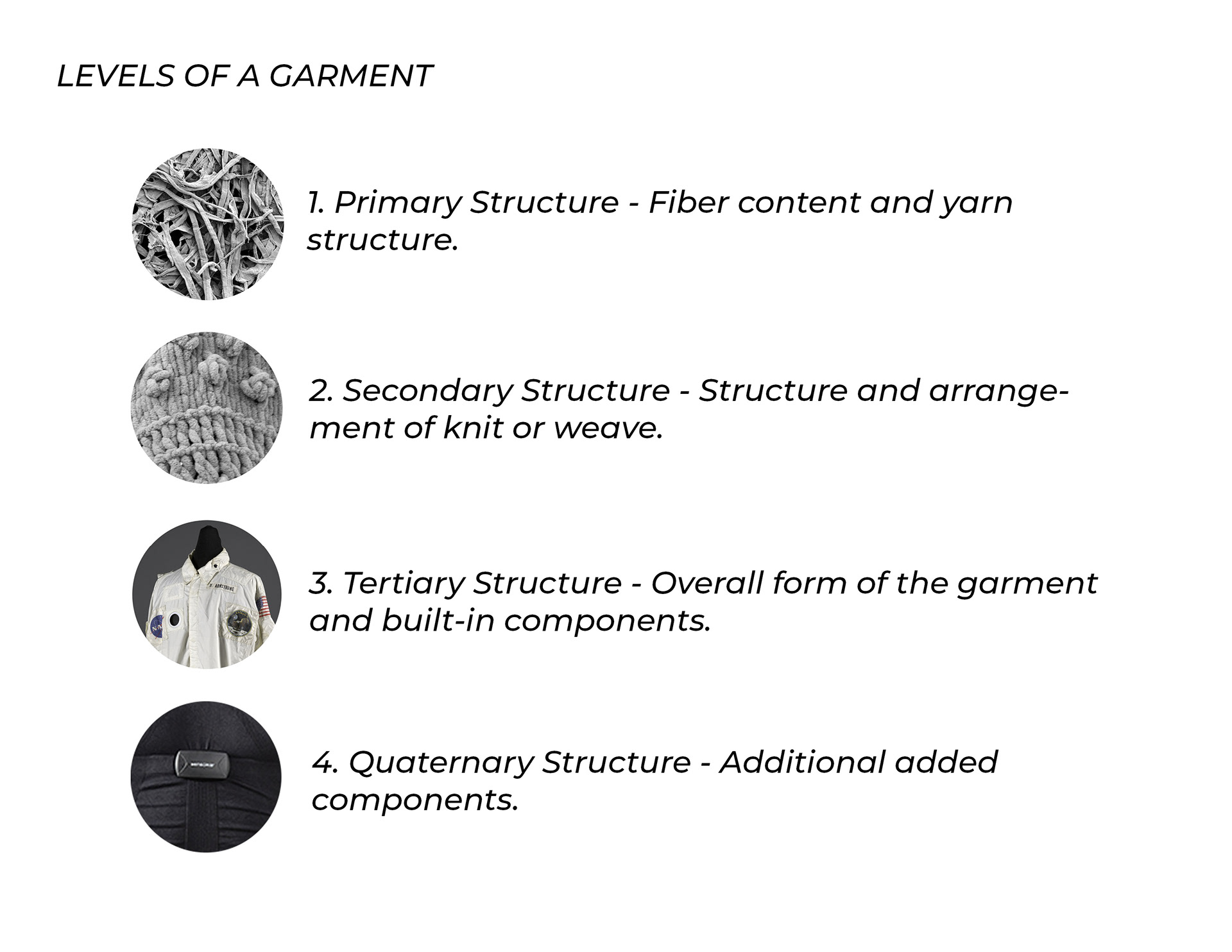The Artemis Collection
Summer 2020 remote design intern project for the NASA Soft Goods Lab, Johnson Space Center (JSC).

The Artemis Collection is a proposal for a series of garments to be worn by the crew of Artemis Missions II and III.
The collection proposed was designed to optimize comfort and seamlessly incorporate additional utilities required for space travel.
This project was completed as part of my remote internship at the NASA Johnson Space Center and later developed in my Fall 2021 RISD Course, “Pack You Bags, We’re Headed to the Moon” taught by Catherine Andreozzi.
My research and final collection were informed by input from and presented to NASA Soft Goods Lab, NASA textile and space architecture engineers and designers, NASA critic and RISD professor Michael Lye, and NASA astronaut Don Pettit.
To support my research I was awarded the Rhode Island Space Grant.
Throughout the course of internship I devised and worked on 3 independent projects: The Artemis Collection, Microgravity Footwear, and the Artemis Wayfinder.
Press related to the course:
Hyperallergic: RISD Students Design Microgravity Socks & Other Apparel for NASA Astronauts
Surface Magazine: RISD students design space apparel that astronauts will wear on future missions.
Artnet: Moonwalk on the Catwalk: See RISD Students’ Designs for the Clothes Astronauts Wear on NASA’s 2025 Lunar Mission
Archinect: RISD students are helping NASA develop its Artemis mission uniforms for 2025
The collection proposed was designed to optimize comfort and seamlessly incorporate additional utilities required for space travel.
This project was completed as part of my remote internship at the NASA Johnson Space Center and later developed in my Fall 2021 RISD Course, “Pack You Bags, We’re Headed to the Moon” taught by Catherine Andreozzi.
My research and final collection were informed by input from and presented to NASA Soft Goods Lab, NASA textile and space architecture engineers and designers, NASA critic and RISD professor Michael Lye, and NASA astronaut Don Pettit.
To support my research I was awarded the Rhode Island Space Grant.
Throughout the course of internship I devised and worked on 3 independent projects: The Artemis Collection, Microgravity Footwear, and the Artemis Wayfinder.
Press related to the course:
Hyperallergic: RISD Students Design Microgravity Socks & Other Apparel for NASA Astronauts
Surface Magazine: RISD students design space apparel that astronauts will wear on future missions.
Artnet: Moonwalk on the Catwalk: See RISD Students’ Designs for the Clothes Astronauts Wear on NASA’s 2025 Lunar Mission
Archinect: RISD students are helping NASA develop its Artemis mission uniforms for 2025
Design Criteria

SpaceX Flight Suit
The garments proposed for the Artemis Mission needed to full-fill the following technical criteria in a visually impactful way:
The Artemis Collection Shall:
1. Use materials that conform to exploration atmosphere safety standards.
2. Maximize the lifespan of each item of clothing.
3. Minimize the overall mass sent up into orbit.
4. Incorporate modifications that increase ease of dressing.
5. Increase the comfort of astronauts in the microgravity environment.
6. Integrate RFID and radiation sensors.
The Artemis Collection Should:
1. Integrate biomedical sensors: heart rate, carbon dioxide, temperature, and breathing rate.
2. Increase the comfort of astronauts: temperature fluctuation accommodations, pinch point relief, easy to use while sleeping or in the lavatory, etc.
3. Incorporate modifications that assist in holding tools/devices.
4. Accommodate a wide variety of body types.
5. Allow for individual customization of the garments.
The Artemis Collection Shall:
1. Use materials that conform to exploration atmosphere safety standards.
2. Maximize the lifespan of each item of clothing.
3. Minimize the overall mass sent up into orbit.
4. Incorporate modifications that increase ease of dressing.
5. Increase the comfort of astronauts in the microgravity environment.
6. Integrate RFID and radiation sensors.
The Artemis Collection Should:
1. Integrate biomedical sensors: heart rate, carbon dioxide, temperature, and breathing rate.
2. Increase the comfort of astronauts: temperature fluctuation accommodations, pinch point relief, easy to use while sleeping or in the lavatory, etc.
3. Incorporate modifications that assist in holding tools/devices.
4. Accommodate a wide variety of body types.
5. Allow for individual customization of the garments.
Research and Design Development



Research produced through consultation with textile, space architecutre, and electrical engineers working for NASA.

Design inspriation derived from sources as varied as the original apparel strategies employed on the Apollo missions to accessible clothing designs.
Final Solution

astronauts face. The design employs color blocking and graphic shapes for functional reasons (for example darker colors in areas where sweat may show) and for the visual purpose of creating a bold, strong image.
The final design can also be converted to one with shortened sleeves and pant legs via removable forearm and calf pieces.
I also designed a tool belt that works seamlessly with the everyday garment and allows for easy organization and storage of tools.
In addition to this everyday garment I presented an exercise garment as well as an optional undergarment design. Both garments utilize some of the same s trategies applied to the everyday garment.




Proposed exercise garment
 Proposed optional undergarment
Proposed optional undergarment
VR simulations aboard the ISS and next to the Orion Space Capsule.